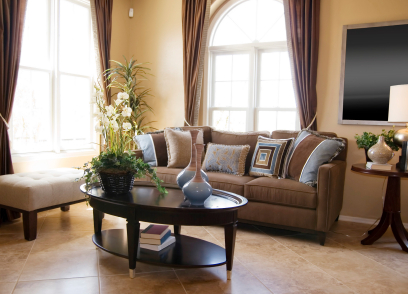For many homeowners, learning how to decorate can be a challenging endeavor. There are so many factors to consider; where to start, how much to spend, how to layout awkward spaces, what type of furniture to buy. We hope that this article will bring some insight to home decoration and give you some interior design basics to help with decorating your home without too many hassles.
The first step in learning how to decorate is to determine your goals, style, and budget. Ask yourself a few questions about your interior design project. Following is a list of questions that should help you self-explore, and determine where to begin with your project.
1. What is the room or area you are decorating?
2. What is the style you would like this room to have?
3. What is the color scheme you would like to use?
4. What pieces of furniture & accessories will you need for this room, and what do you already have (and how much money are you willing to spend)?
5. How will you layout the space?
These questions are a great starting point to get you thinking about how to approach your interior decorating project. Determining the room you are going to be working on will help you to focus on one particular area, rather than becoming overwhelmed by a whole house, or multiple room projects. Do keep in mind, however that your color scheme and style should flow with other areas of the house.
Determining your style and color scheme are key elements in any room. These will help you set a direction and keep you on track in making choices. You can get interior design ideas from
magazines, internet websites, furniture stores, and from other people’s homes. Make mental notes about what you specifically like and dislike. As you look in furniture stores and online, be sure to make mental notes about the prices of the things you like. This will help you to determine a
budget for your project.
You will almost always need to measure the room you are working on so that you know exactly what sized of furniture will fit in the room. If you are creative enough, learn how to draw out a floor plan to show you how to arrange furniture. It can be very expensive and time-consuming to purchase furniture that doesn’t fit in your room, or is ridiculously over, or under scale.
When learning how to decorate, be open to learning and getting interior design ideas from magazines, books and
internet sources. Always keep your eyes open for things that you like, and constantly make mental notes about what you like and why. One of the most important interior design basics when starting a project, is to be sure to plan things out. Make the mistakes on paper, and in your mind, before you make the mistakes on your room. This will save you lots of time and effort!
Find more great ideas for budget decorating at
http://www.designingonabudget.com, and great home décor tips & resources at
http://www.sullivaninteriors.net. Angela Sullivan, ASID is an Interior Designer and budget decorating enthusiast. This article may be reproduced as long as it is not changed, and remains intact, including all links and this statement.
Decorating on a budget,
How To Decorate,
Interior Design Basics,
Budget DecoratingLabels: Apartment Decorating, Interior Decorating














